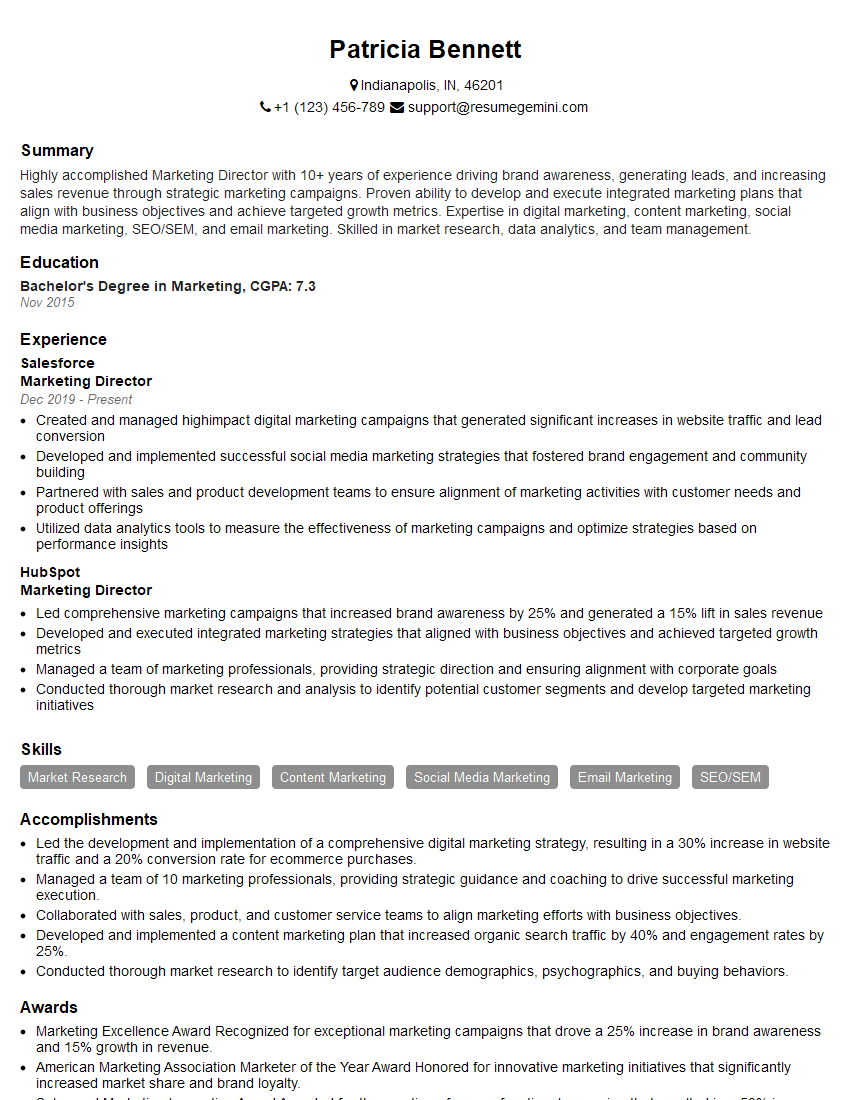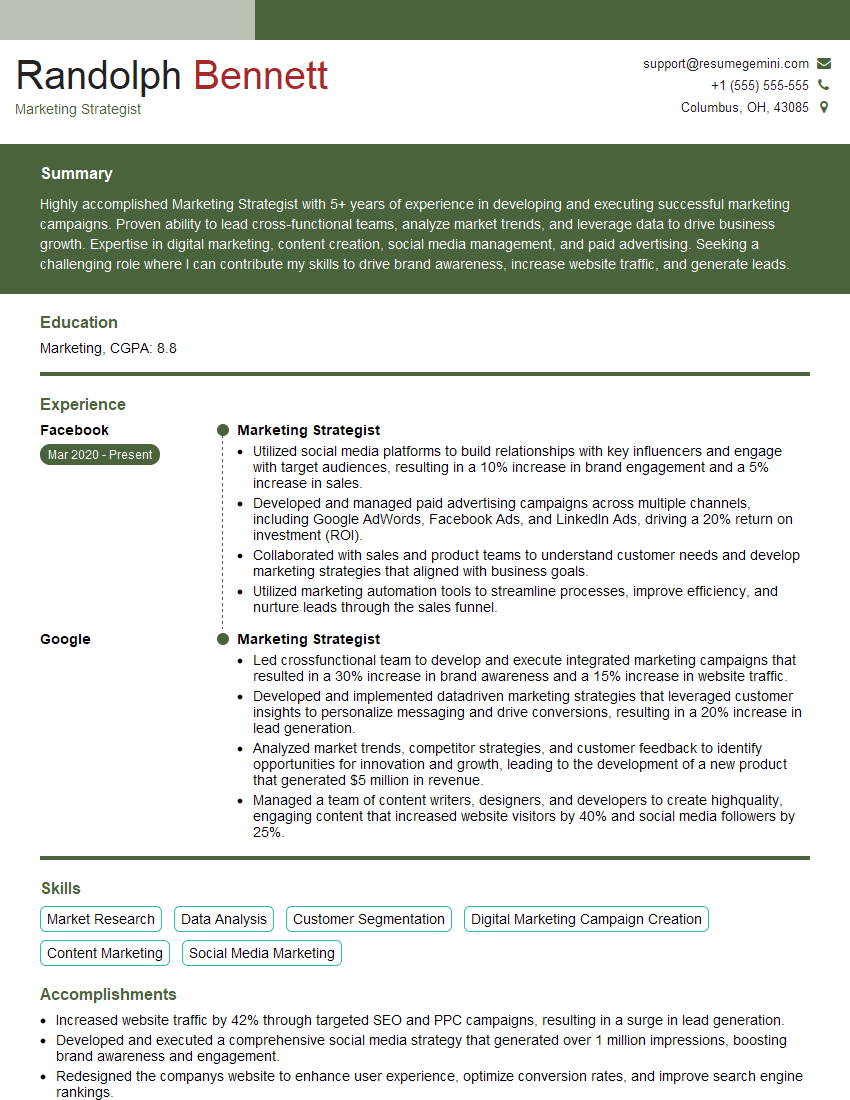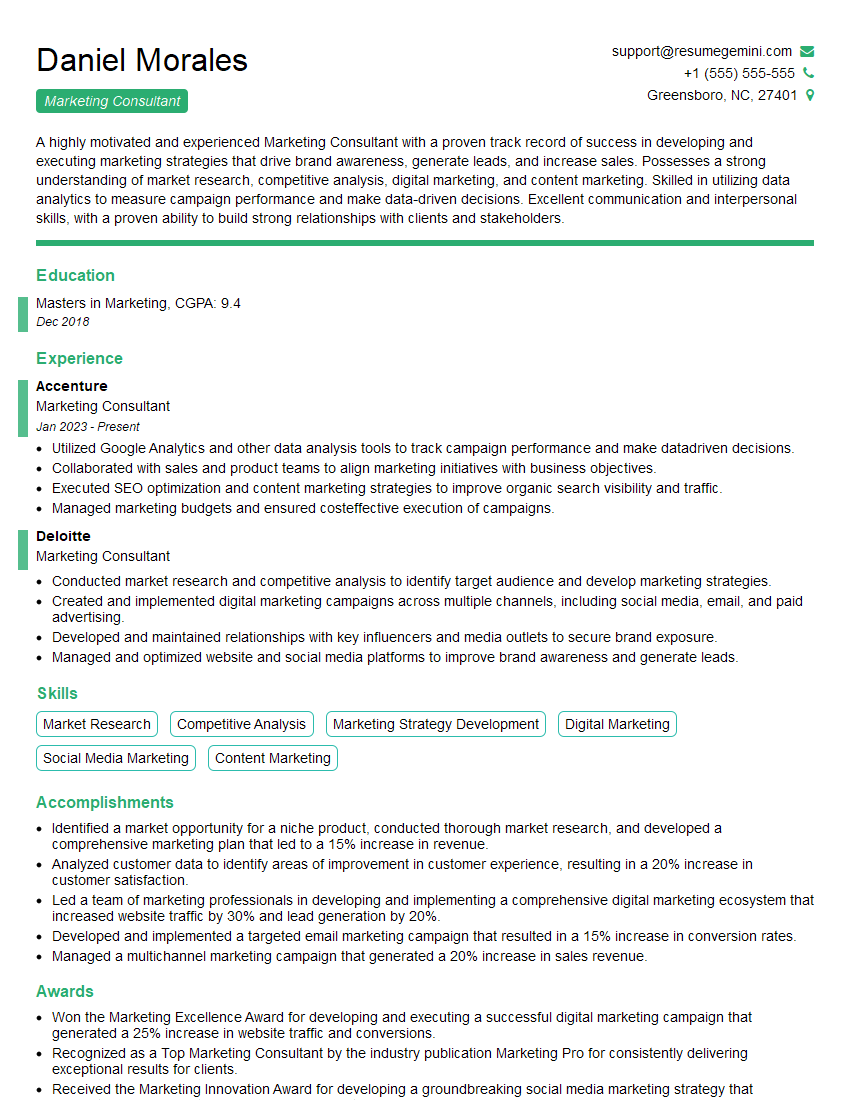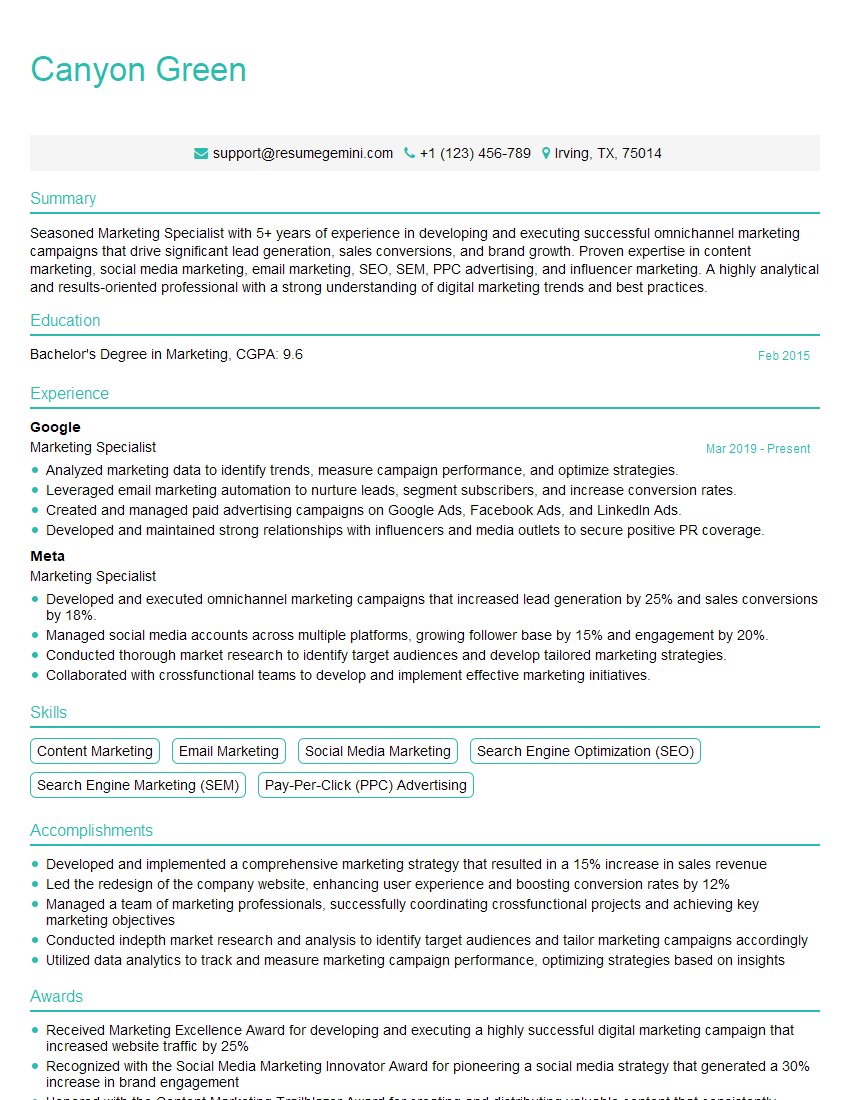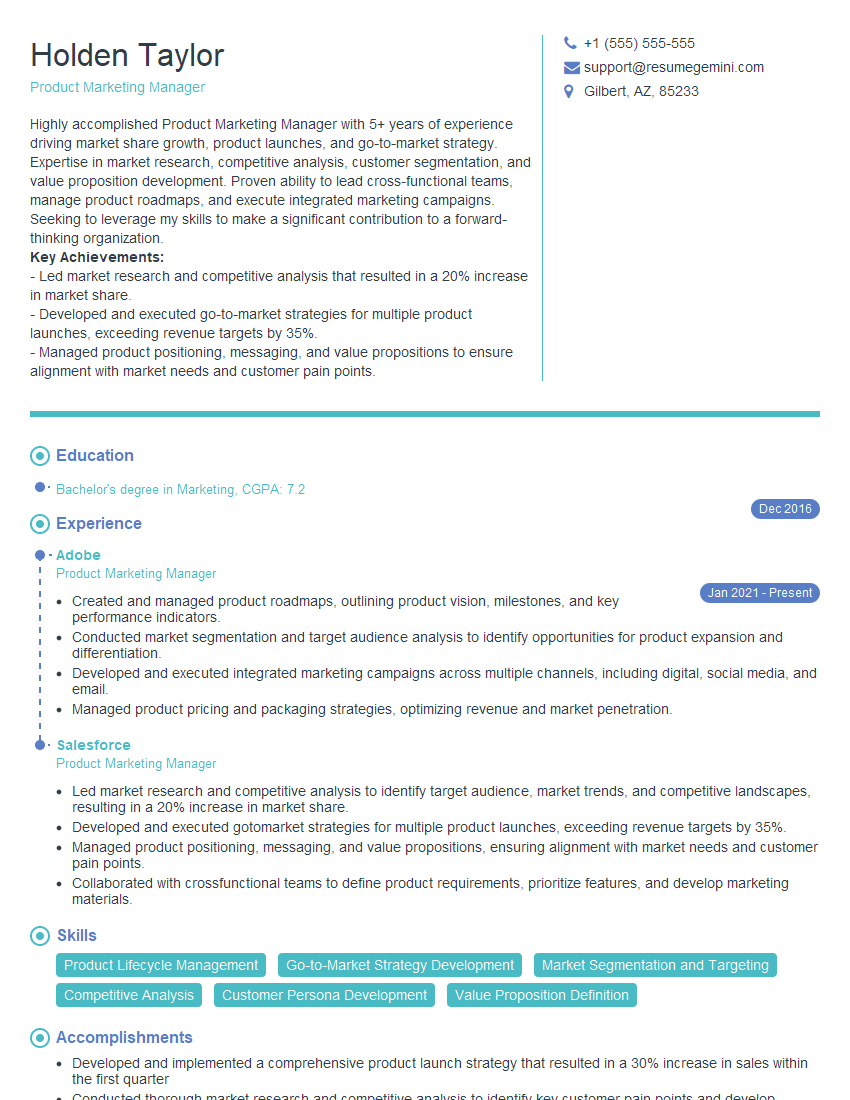Cracking a skill-specific interview, like one for Collaboration with marketing team, requires understanding the nuances of the role. In this blog, we present the questions you’re most likely to encounter, along with insights into how to answer them effectively. Let’s ensure you’re ready to make a strong impression.
Questions Asked in Collaboration with marketing team Interview
Q 1. Describe your experience collaborating with different marketing departments (e.g., content, social media, email).
Throughout my career, I’ve collaborated extensively with diverse marketing departments, including content, social media, and email marketing teams. My approach centers on building strong, trusting relationships based on open communication and mutual respect. I understand that each team has its own unique expertise and perspective, and I strive to leverage these strengths for a unified marketing strategy.
For instance, when launching a new product, I worked closely with the content team to develop engaging blog posts and website copy that highlighted key features and benefits. Simultaneously, I partnered with the social media team to craft a compelling social media campaign that amplified the message and reached the target audience through targeted ads and organic content. The email marketing team then created a series of automated email sequences to nurture leads and drive conversions. Regular meetings and shared project management tools ensured everyone stayed informed and on the same page throughout the process. This collaborative approach resulted in a highly successful product launch that exceeded expectations.
Q 2. How do you ensure alignment between marketing strategies and overall business objectives?
Aligning marketing strategies with overall business objectives requires a clear understanding of the company’s goals and key performance indicators (KPIs). This begins with active participation in strategic planning sessions, where I work with the executive team and other departments to define overarching business goals. Then, I translate these goals into measurable marketing objectives. For example, if the overarching business goal is to increase market share by 15%, I would define specific marketing objectives such as increasing website traffic by 20%, improving lead generation by 25%, and boosting brand awareness by 10%. I use data-driven insights and regular performance monitoring to measure progress against these objectives and make adjustments as needed. This ensures that marketing efforts are not only creative and engaging but also directly contribute to the company’s bottom line.
Q 3. Explain your approach to resolving conflicts within a marketing team.
Conflict is inevitable in any team environment, but it’s how we manage conflict that determines success. My approach involves fostering a culture of open and honest communication, where team members feel comfortable expressing their opinions and concerns without fear of reprisal. When conflicts arise, I facilitate a structured discussion to understand the root cause. This might involve individually speaking with each party to grasp their perspectives, before bringing them together in a neutral environment to discuss the issue. I focus on finding common ground and creating a collaborative solution that benefits the entire team. I always prioritize finding solutions that balance the needs of different individuals with the needs of the larger marketing goals. Documentation of agreed-upon solutions helps to reinforce positive team dynamics.
Q 4. How do you handle conflicting priorities among team members?
Prioritization is crucial, especially when dealing with competing demands. My strategy involves utilizing a clear and well-defined process. I start by creating a centralized task management system (e.g., using a project management software like Asana or Trello) where all tasks and deadlines are clearly outlined. Then, we work together as a team to prioritize tasks based on their urgency and importance, considering factors like impact on business objectives, deadlines, and resource availability. This may involve using a prioritization matrix, such as the Eisenhower Matrix (Urgent/Important), to categorize tasks and establish clear priorities. Regular check-ins and status updates ensure everyone remains aligned and any emerging conflicts are addressed promptly.
Q 5. Describe a time you had to negotiate with a team member to achieve a common goal.
In a previous role, we were launching a new marketing campaign with a tight deadline. The social media team preferred a specific influencer collaboration, while the content team felt a different approach focusing on organic content would be more impactful. Initially, this led to some friction. I facilitated a meeting where each team presented their arguments and rationale. I listened actively, emphasizing the value of both approaches. We eventually reached a compromise: a phased approach, starting with organic content to build momentum, followed by the influencer collaboration to amplify reach. This negotiation not only satisfied both teams but also resulted in a more comprehensive and ultimately more successful campaign.
Q 6. What tools or technologies do you use to facilitate collaboration within a marketing team?
Effective collaboration relies on the right tools. We utilize several technologies, including:
- Project Management Software: Asana, Trello, or Monday.com for task assignment, progress tracking, and communication.
- Communication Platforms: Slack or Microsoft Teams for instant messaging and file sharing.
- Collaboration Documents: Google Docs or Microsoft Office 365 for shared documents that enable real-time co-editing.
- Data Visualization Tools: Data Studio or Tableau for creating insightful reports and dashboards that allow everyone to easily understand marketing performance.
The choice of tools is often based on the team’s preferences and the specific project requirements, but the goal is always to streamline workflows and improve communication.
Q 7. How do you effectively communicate marketing strategies and results to stakeholders?
Communicating marketing strategies and results to stakeholders requires clear, concise, and visually engaging presentations. I adapt my communication style to the audience. For executive teams, I focus on high-level summaries, emphasizing key metrics and their impact on the business. For operational teams, I provide more detailed reports, including specific data points and actionable insights. I use data visualization tools to present information in an accessible format, using charts, graphs, and dashboards to illustrate key performance indicators. Regular reports, both written and verbal, keep stakeholders informed and allow for timely adjustments to the marketing strategy. This consistent communication ensures transparency and buy-in from stakeholders at all levels.
Q 8. Describe your experience with project management tools for marketing collaboration.
My experience with project management tools for marketing collaboration is extensive. I’ve utilized a range of tools, adapting my choice based on project needs and team size. For smaller projects or quick tasks, tools like Asana or Trello are efficient for task assignment, progress tracking, and file sharing. Their visual boards make it easy to monitor workflow and identify bottlenecks. For larger, more complex campaigns involving multiple stakeholders and intricate timelines, I prefer platforms like Monday.com or Wrike. These offer more robust features like Gantt charts for visualizing project timelines, resource allocation tools, and advanced reporting capabilities. In one instance, using Monday.com for a large-scale product launch campaign allowed us to effectively manage over 20 tasks across five different teams, ensuring everyone remained aligned and accountable. Crucially, I always ensure the chosen tool is user-friendly and integrates well with other marketing software we use, like our CRM or email marketing platform, avoiding unnecessary complexity and data silos.
Q 9. How do you measure the success of collaborative marketing efforts?
Measuring the success of collaborative marketing efforts requires a multi-faceted approach, going beyond simple vanity metrics. We start by defining clear, measurable, achievable, relevant, and time-bound (SMART) goals at the outset of each campaign. Key Performance Indicators (KPIs) are then chosen to track progress toward these goals. This might include website traffic, lead generation rates, conversion rates, social media engagement (likes, shares, comments), brand mentions, and ultimately, return on investment (ROI). For instance, for a recent social media campaign, we tracked engagement rate and website traffic alongside lead generation from a dedicated landing page. Comparing these results to previous campaigns or industry benchmarks provided a clear picture of its success. Regular reporting and analysis, using dashboards or reporting tools, are crucial for identifying trends, areas for improvement, and demonstrating the value of collaborative efforts to stakeholders.
Q 10. Explain your process for providing constructive feedback to team members.
Providing constructive feedback is a crucial skill in fostering a collaborative environment. My approach focuses on being specific, timely, and solution-oriented. I always start by highlighting positive aspects of the work before addressing areas for improvement. Instead of focusing on personal flaws, I frame my feedback around the work itself, using the ‘Situation-Behavior-Impact’ (SBI) model. For example, I’d say, ‘In the recent email campaign (Situation), the subject line lacked a clear call to action (Behavior), resulting in lower click-through rates (Impact). Let’s explore alternative subject line approaches for future campaigns.’ I always encourage a two-way conversation, allowing for clarification and mutual understanding. The goal isn’t to criticize, but to facilitate growth and improvement. Following up on the feedback to see if the suggested changes have been implemented and if they’ve been effective ensures learning and accountability.
Q 11. How do you handle situations where team members are not meeting deadlines or expectations?
When team members aren’t meeting deadlines or expectations, I address the situation promptly and privately. First, I schedule a meeting to understand the root cause. Are there external factors, such as resource constraints or conflicting priorities? Or are there internal factors, such as a lack of clarity on the task or insufficient skills? Once the reason is understood, we collaboratively develop a solution. This might involve re-prioritizing tasks, providing additional training or support, adjusting deadlines, or reassigning responsibilities. Open communication is key; I want team members to feel comfortable voicing their challenges. However, consistent failure to meet expectations warrants a more formal process, involving documentation and potentially performance management discussions with the relevant manager. The objective is always to support the team member while ensuring project success.
Q 12. How do you build consensus within a marketing team on key decisions?
Building consensus within a marketing team requires active listening, clear communication, and a collaborative decision-making process. I usually begin by presenting the issue clearly, outlining different options, and the pros and cons of each. I then facilitate open discussion, encouraging everyone to share their perspectives and concerns. This may involve brainstorming sessions, using techniques like mind mapping or SWOT analysis to explore all facets of the decision. I aim to identify common ground and address objections constructively. If a unanimous decision isn’t achievable, I guide the team towards a solution that accommodates the majority’s needs while minimizing the negative impact on dissenting voices. Documenting the decision-making process and agreed-upon plan helps maintain transparency and accountability throughout the implementation phase.
Q 13. Describe a time you had to adapt your approach to collaboration due to unexpected changes.
During a major product launch, our initial marketing strategy relied heavily on in-person events. However, due to unforeseen circumstances (a sudden and widespread illness outbreak), we had to swiftly adapt our approach. I immediately convened a team meeting to reassess our plans. We decided to pivot towards a digital-first strategy, enhancing our online presence, leveraging social media, and focusing on targeted digital advertising. This required a rapid shift in resource allocation and the acquisition of new skills within the team. We held intensive workshops on digital marketing best practices, cross-trained team members, and leveraged external expertise where necessary. This adaptability allowed us to successfully launch the product, albeit with a revised strategy, and demonstrate resilience in the face of unexpected challenges.
Q 14. How do you foster a positive and productive team environment?
Fostering a positive and productive team environment involves creating a culture of trust, respect, and open communication. I prioritize regular team meetings, not just for updates, but for informal discussions and team-building activities. Acknowledging and celebrating successes, both big and small, is crucial for boosting morale and reinforcing positive behavior. I actively encourage knowledge sharing, peer-to-peer mentoring, and feedback sessions. Providing opportunities for professional development, such as attending conferences or workshops, helps team members feel valued and invested in their growth. I also focus on creating a flexible and supportive work environment, recognizing the importance of work-life balance and respecting individual needs. By fostering a sense of community and mutual support, I aim to build a high-performing team that is not only productive but also happy and engaged.
Q 15. How do you manage multiple projects simultaneously with a collaborative team?
Managing multiple projects simultaneously requires a structured approach and effective communication. I utilize project management methodologies like Agile, breaking down large projects into smaller, manageable tasks. This allows for better prioritization and tracking of progress. I also rely heavily on collaborative tools like Asana or Monday.com to visualize the workflow, assign tasks, and set deadlines. For example, in a recent campaign involving a website redesign, social media push, and email marketing blitz, we utilized Asana to create separate project boards for each initiative, assigning tasks to specific team members with clear deadlines. Each board had its own timeline, enabling us to monitor progress across all three concurrently. Regular team meetings focused on progress reports and addressing any roadblocks were crucial.
Furthermore, I prioritize clear communication about project dependencies to avoid conflicts. For instance, if the website redesign is dependent on updated brand assets, we ensure that the design team understands this dependency and delivers on time. This prevents one project from delaying others, maintaining the overall project timeline.
Career Expert Tips:
- Ace those interviews! Prepare effectively by reviewing the Top 50 Most Common Interview Questions on ResumeGemini.
- Navigate your job search with confidence! Explore a wide range of Career Tips on ResumeGemini. Learn about common challenges and recommendations to overcome them.
- Craft the perfect resume! Master the Art of Resume Writing with ResumeGemini’s guide. Showcase your unique qualifications and achievements effectively.
- Don’t miss out on holiday savings! Build your dream resume with ResumeGemini’s ATS optimized templates.
Q 16. How do you ensure all team members are aware of and understand their roles and responsibilities?
Ensuring clarity on roles and responsibilities is paramount for a smoothly functioning team. At the outset of a project, I create a detailed RACI matrix (Responsible, Accountable, Consulted, Informed). This document clearly outlines who is responsible for each task, who is accountable for the overall outcome, who needs to be consulted, and who needs to be kept informed. We review and discuss this matrix as a team, ensuring everyone understands their role and how their work contributes to the bigger picture. For instance, in a content marketing project, the content writer is responsible for creating the blog post, the editor is accountable for its quality and accuracy, the SEO specialist is consulted on keyword optimization, and the social media manager is informed of the launch.
Regular check-ins and open communication channels further solidify role understanding. This helps identify and address any misunderstandings or role ambiguity early on, preventing potential conflicts and inefficiencies.
Q 17. Explain your experience using marketing collaboration platforms (e.g., Slack, Asana, Monday.com).
I have extensive experience leveraging marketing collaboration platforms such as Slack, Asana, and Monday.com to streamline workflows and foster effective communication. Slack serves as our primary communication hub for quick updates, questions, and informal discussions. Asana and Monday.com are used for more structured project management, task assignment, progress tracking, and file sharing. I’ve found Asana particularly effective for managing complex projects with multiple dependencies, while Monday.com excels in its visual dashboards and reporting capabilities.
For example, during a recent product launch, we used Slack for quick announcements and daily stand-ups, Asana for managing the detailed tasks related to content creation, and Monday.com for tracking the overall campaign performance against key metrics. Each platform’s strengths were leveraged to optimize the project’s execution. I’m proficient in using these tools’ features, such as Kanban boards, Gantt charts, and custom workflows, to tailor the platform to specific project needs.
Q 18. How do you handle disagreements regarding marketing strategies or tactics?
Disagreements are inevitable in a collaborative environment. My approach focuses on constructive conflict resolution. I encourage open and respectful dialogue, ensuring everyone feels comfortable expressing their opinions and perspectives. I facilitate discussions by actively listening to each viewpoint, asking clarifying questions, and identifying the root cause of the disagreement. Data-driven decision making is crucial. We often refer to market research, customer insights, or past campaign performance to inform our choices.
If a consensus cannot be easily reached, we might explore A/B testing different strategies or tactics to gather data and make an informed decision. The goal is not to avoid disagreement but to use it as an opportunity for learning and improvement, ultimately arriving at the best possible solution for the campaign. For instance, if there’s a debate on whether to focus on Facebook or Instagram ads, we might test both platforms simultaneously, analyzing the results to inform future resource allocation.
Q 19. How do you contribute to a positive and collaborative work culture within a marketing team?
Contributing to a positive and collaborative work culture is a top priority. I believe in fostering a respectful and inclusive environment where every team member feels valued and heard. I actively encourage open communication, celebrating successes, and acknowledging individual contributions. This can include regular team lunches, informal social gatherings, or simply acknowledging individual efforts during team meetings. I champion a culture of learning and development, encouraging team members to share their expertise and learn from each other. For example, I organize regular knowledge sharing sessions where team members can present case studies or share best practices.
Furthermore, I provide constructive feedback and mentorship, helping team members grow professionally. I strive to create a culture of trust and psychological safety, where individuals feel empowered to take risks and share ideas without fear of judgment. This creates a more dynamic and creative environment, resulting in better ideas and more effective teamwork.
Q 20. Describe your experience with Agile or other iterative marketing methodologies.
I have extensive experience working with Agile marketing methodologies. I find the iterative nature of Agile, with its emphasis on short sprints and continuous feedback, particularly well-suited to the dynamic nature of marketing. The Agile framework allows for flexibility and adaptability, enabling us to respond quickly to changing market conditions or customer feedback. We typically use a Scrum framework, with daily stand-up meetings to track progress, sprint planning sessions to define tasks, and sprint retrospectives to identify areas for improvement.
For example, in a recent campaign, we broke down the project into two-week sprints. Each sprint focused on a specific aspect of the campaign, such as content creation, social media engagement, or email marketing. This allowed us to monitor progress closely, make adjustments as needed, and deliver value incrementally. The iterative nature ensured that we could incorporate feedback throughout the process and optimize our approach as we went along.
Q 21. How do you measure and track individual and team performance in a collaborative marketing environment?
Measuring and tracking performance in a collaborative marketing environment requires a multifaceted approach. We use a combination of quantitative and qualitative metrics to assess both individual and team performance. Quantitative metrics include website traffic, lead generation, conversion rates, social media engagement, and ROI. We track these using analytics platforms like Google Analytics and social media analytics dashboards. These data points provide objective insights into campaign effectiveness.
Qualitative metrics are equally important. We conduct regular surveys and feedback sessions to gauge customer satisfaction and team morale. We also track individual contributions through project management tools, monitoring task completion, quality of work, and adherence to deadlines. This allows us to identify areas of strength and areas needing improvement, informing performance reviews and training opportunities. Regular performance reports and team meetings ensure transparency and accountability, fostering a culture of continuous improvement.
Q 22. How do you manage the flow of information within a large marketing team?
Managing information flow in a large marketing team requires a structured approach. Think of it like a well-oiled machine – each part needs to know what the others are doing to function efficiently. I leverage a multi-pronged strategy:
- Centralized Communication Hub: We use a project management tool like Asana or Monday.com. This ensures all team members have access to the same information, deadlines, and project updates, minimizing confusion and missed deadlines.
- Regular Team Meetings: Weekly stand-up meetings and monthly progress reviews are crucial for open dialogue. These provide a platform to share updates, discuss challenges, and brainstorm solutions collaboratively. Keeping meetings concise and action-oriented is key.
- Clearly Defined Roles and Responsibilities: Each team member understands their individual contribution to the overall marketing strategy. A detailed RACI matrix (Responsible, Accountable, Consulted, Informed) clarifies who owns what, preventing duplication of effort and confusion.
- Internal Communication Channels: Utilizing a platform like Slack for quick questions and informal updates promotes a fast-paced, responsive communication flow.
For example, in a recent campaign, our project management tool allowed us to track the progress of different aspects, from content creation to social media scheduling, in real-time, leading to smoother execution and improved collaboration.
Q 23. Describe your approach to delegation and task assignment within a marketing team.
My approach to delegation is based on trust, empowerment, and clear expectations. I believe in assigning tasks based on individual strengths and career development goals. It’s not just about getting the job done; it’s about growing the team’s capabilities.
- Skill Assessment: I begin by evaluating each team member’s skills and experience. This ensures tasks are aligned with their capabilities, fostering both efficiency and satisfaction.
- Clear Objectives and Deadlines: Every task is assigned with crystal-clear objectives, expected deliverables, and realistic deadlines. This prevents misunderstandings and ensures everyone is on the same page.
- Regular Check-ins: I schedule regular check-ins to provide support, answer questions, and monitor progress. This open communication keeps me aware of any roadblocks and allows me to offer timely assistance.
- Empowerment and Autonomy: I encourage team members to take ownership of their tasks and make decisions within their scope. This fosters responsibility and promotes a sense of value within the team.
For instance, when launching a new product, I delegated different aspects – content marketing, social media, email campaigns – to individuals based on their expertise, allowing them to take the lead while I provided overall guidance and support.
Q 24. How do you incorporate feedback from various team members into your marketing plans?
Incorporating feedback is crucial for creating effective marketing plans. I view feedback as a valuable resource that enhances our strategies and outcomes. My approach is threefold:
- Formal Feedback Mechanisms: We conduct regular feedback sessions, using surveys, focus groups, or individual meetings to gather input. This structured approach ensures we capture a wide range of perspectives.
- Open Communication Channels: Encouraging open communication throughout the project lifecycle allows for continuous feedback and adjustments. This includes informal discussions, brainstorming sessions, and quick check-ins.
- Data-Driven Decision Making: We use data analytics to measure the success of our campaigns and inform future adjustments. Website analytics, social media engagement metrics, and sales data all contribute to a data-driven feedback loop.
For example, during a recent campaign, early feedback from a customer survey revealed a misunderstanding of our messaging. This feedback was incorporated to revise our materials, which ultimately improved campaign performance.
Q 25. How do you handle situations where team members have differing opinions or skill sets?
Differing opinions and skill sets are not obstacles; they are strengths. They fuel innovation and lead to more robust solutions. I approach these situations with a focus on collaboration and constructive dialogue.
- Facilitated Discussions: I create a safe space for open discussions, where team members feel comfortable expressing their opinions, even if they differ. I act as a facilitator, ensuring respectful communication and productive problem-solving.
- Leveraging Diverse Skill Sets: I emphasize the complementary nature of different skills and perspectives. By actively drawing upon everyone’s expertise, we create more comprehensive and innovative solutions.
- Data-Driven Compromise: When facing conflicting viewpoints, I encourage the use of data to support arguments and inform decisions. This ensures objective evaluation and reduces reliance on subjective opinions.
- Conflict Resolution Techniques: I am trained in conflict resolution techniques to effectively mediate disputes and ensure a positive outcome for the team.
In a recent project, two team members had significantly different approaches to a design element. Through open discussion and presenting data on user preferences, we reached a consensus that incorporated the best elements of both ideas.
Q 26. Describe your experience with cross-functional collaboration within the marketing department.
Cross-functional collaboration is essential for comprehensive marketing success. My experience highlights the importance of clear communication and shared goals. I’ve actively participated in projects involving sales, product development, and customer service teams.
- Shared Goals and Objectives: Before starting any cross-functional project, we define shared goals and KPIs to ensure alignment and avoid conflicting priorities.
- Regular Joint Meetings: We establish regular meetings with representatives from each team to share updates, discuss challenges, and ensure seamless integration.
- Documenting Processes and Decisions: Detailed documentation of key decisions, processes, and responsibilities ensures everyone is informed and minimizes confusion.
- Building Relationships: Strong relationships between team members foster trust and facilitate efficient collaboration. This includes casual interactions and team-building activities.
For example, in a new product launch, I worked closely with the product development team to ensure marketing materials accurately reflected product features. This collaboration resulted in a successful product launch with strong customer engagement.
Q 27. How do you maintain open communication and transparency within a marketing team?
Maintaining open communication and transparency is crucial for a high-performing marketing team. This fosters trust, accountability, and a sense of shared purpose. My strategies include:
- Transparent Communication: Sharing information openly and honestly, including both successes and challenges, builds trust and strengthens the team.
- Regular Feedback Loops: Establishing regular feedback loops, both formal and informal, allows for continuous improvement and ensures everyone feels heard.
- Open-Door Policy: Encouraging open dialogue and making myself accessible promotes a culture of trust and ensures concerns are addressed promptly.
- Team-Building Activities: Organizing team-building activities fosters camaraderie and strengthens working relationships.
For instance, during challenging periods, transparency about budget constraints and strategic adjustments allows the team to adapt proactively and find creative solutions together.
Q 28. How have you adapted your collaboration skills to work effectively in remote or hybrid work environments?
Adapting to remote or hybrid work environments requires a conscious effort to maintain communication and collaboration. I’ve found several effective strategies:
- Leveraging Technology: Using tools like video conferencing, project management software, and instant messaging allows for seamless communication and collaboration, regardless of location.
- Structured Communication: Establishing clear communication protocols, including scheduled meetings and response times, helps prevent confusion and ensures timely feedback.
- Virtual Team Building: Organizing virtual team-building activities helps maintain team morale and strengthen relationships in a remote setting.
- Asynchronous Communication: Utilizing asynchronous communication methods like email and project management tools allows team members to work flexibly and collaborate effectively across time zones.
For example, during the pandemic, our team successfully transitioned to a fully remote work model by adopting a combination of these strategies. Regular virtual check-ins, clear communication protocols, and a focus on team wellbeing ensured productivity and maintained a positive work environment.
Key Topics to Learn for Collaboration with Marketing Team Interview
- Understanding Marketing Objectives: Learn how to effectively translate marketing goals into actionable strategies and deliverables. This includes understanding KPIs and measuring success.
- Project Management & Workflow: Mastering collaboration tools and processes to ensure smooth project execution. This includes agile methodologies, task management, and communication protocols.
- Communication & Feedback: Develop your ability to clearly communicate ideas, provide constructive feedback, and actively listen to the marketing team’s perspectives. Practice giving and receiving criticism professionally.
- Data Analysis & Interpretation: Understand how marketing data informs decision-making. Learn to interpret key metrics and use data to support your recommendations.
- Marketing Channels & Strategies: Familiarize yourself with various marketing channels (e.g., social media, email, content marketing) and common marketing strategies. Understand how different channels work together.
- Problem-Solving & Conflict Resolution: Practice scenarios where you had to resolve conflicts or find creative solutions to marketing challenges. Highlight your ability to collaborate effectively even with differing viewpoints.
- Brand Consistency & Messaging: Demonstrate your understanding of maintaining a consistent brand voice and messaging across all marketing channels. This includes understanding brand guidelines and their importance.
Next Steps
Mastering collaboration with marketing teams is crucial for career advancement. It demonstrates your ability to work effectively within a cross-functional environment, contributing to successful marketing campaigns and overall company growth. To maximize your job prospects, create an ATS-friendly resume that highlights your relevant skills and experience. ResumeGemini is a trusted resource to help you build a professional and impactful resume. Examples of resumes tailored to showcasing collaboration with marketing teams are available to help you get started.
Explore more articles
Users Rating of Our Blogs
Share Your Experience
We value your feedback! Please rate our content and share your thoughts (optional).
What Readers Say About Our Blog
Hi, I’m Jay, we have a few potential clients that are interested in your services, thought you might be a good fit. I’d love to talk about the details, when do you have time to talk?
Best,
Jay
Founder | CEO

